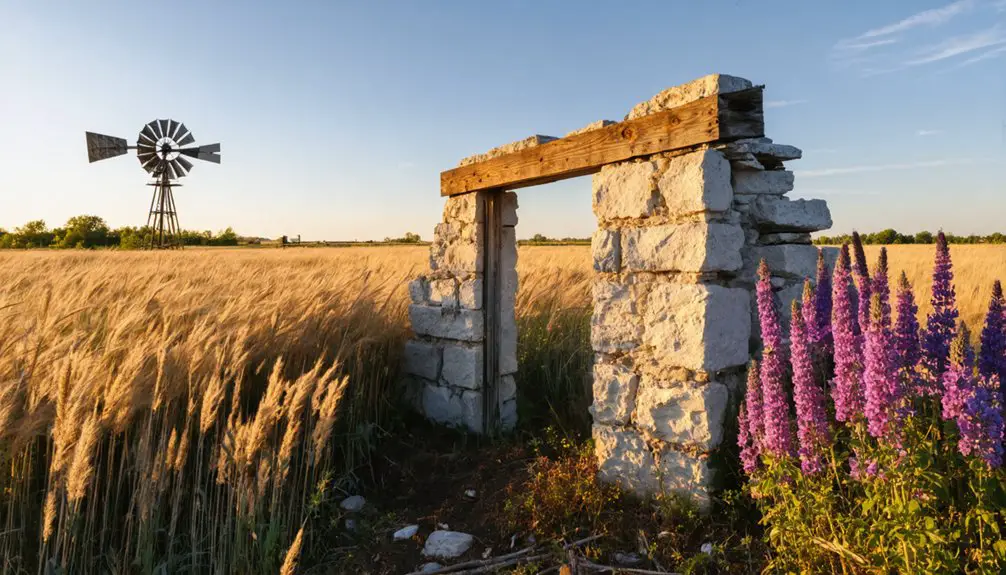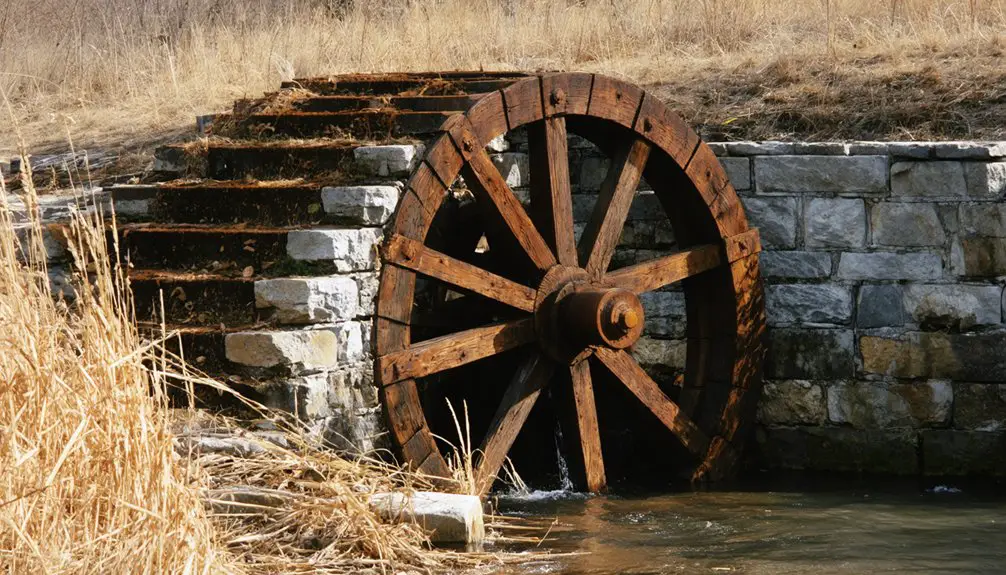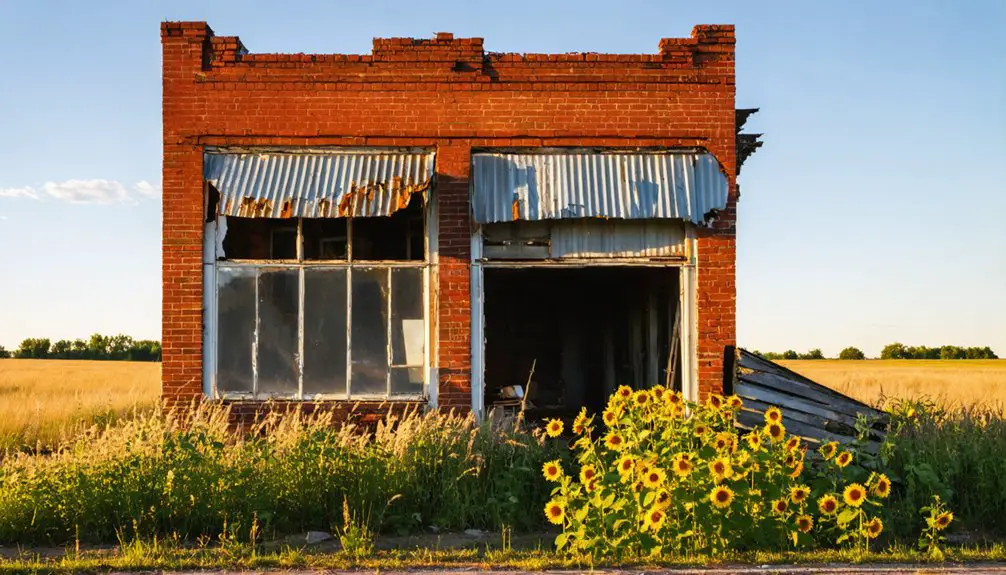You’ll find Monmouth’s ghost town remains in Crawford County, Kansas, where Lafayette Manlove established a frontier settlement in the 1860s. The town flourished along Lightning and Limestone Creeks, growing to 200 residents by 1878 with schools, churches, and a bustling agricultural trade center. Though the Memphis, Kansas & Colorado Railroad brought prosperity in 1879, the community couldn’t sustain itself, and its abandoned structures now tell stories of pioneer ambition and Southeast Kansas’s “Little Balkans” heritage.
Key Takeaways
- Monmouth, Kansas was established in the 1860s and grew to 200 residents by 1878 before ultimately becoming a ghost town.
- The town flourished as an agricultural trade center with two general stores, churches, and schools until economic decline set in.
- Railroad service through Monmouth initially boosted growth but its later decline contributed significantly to the town’s abandonment.
- The closure of the post office and loss of essential institutions marked critical turning points in Monmouth’s transformation into a ghost town.
- Young residents moving to urban areas and competition from neighboring towns with stronger economies led to Monmouth’s eventual desertion.
A Pioneer’s Vision: Lafayette Manlove’s Settlement
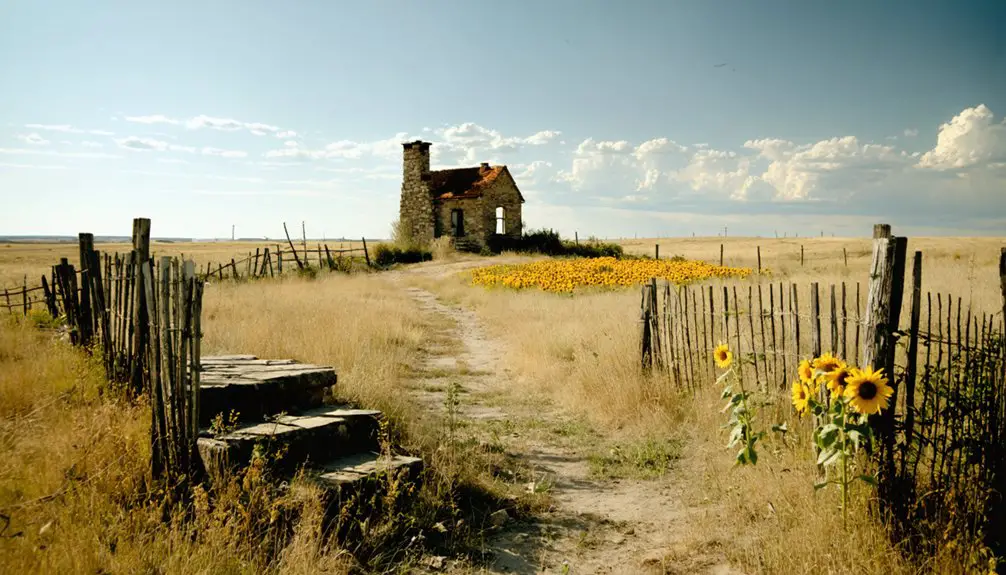
When Lafayette Manlove established Monmouth, Kansas in the 1860s, he brought more than just his Illinois hometown’s name to Crawford County – he carried a pioneering vision for organized settlement in the post-Civil War frontier.
You’ll find Manlove’s pioneer leadership reflected in every aspect of early Monmouth’s development. He built the town’s first structure, a log store room, and secured essential infrastructure by establishing the post office in 1866, where he served as postmaster. The arrival of the narrow-gauge railroad in 1879 connecting Cherokee to Parsons helped spur the town’s growth and development.
His community planning extended beyond Monmouth’s borders – as a special commissioner, he helped organize Crawford County in 1867, dividing it into townships and districts. When the county clerk position opened, Manlove stepped in, demonstrating his commitment to building strong local governance during these formative years. The settlement emerged during a tumultuous period when guerrillas and bushwhackers threatened the safety of local settlers.
Life Along Lightning and Limestone Creeks
Along the winding paths of Lightning and Limestone Creeks, Monmouth’s settlers built a thriving community that capitalized on these crucial waterways. You’d have found the creek ecosystems supporting diverse agricultural practices, from grain fields to hog farming, while sawmills harnessed the water’s power for lumber production. The town’s strategic location helped establish it as a key shipping point, with 200 residents by 1878 contributing to its economic growth. The fertile soil, reaching depths of 1 to 5 feet, enabled successful farming ventures along the creek banks.
The creeks shaped daily life in profound ways. You could’ve witnessed farmers moving their livestock along water-adjacent routes, while stagecoaches followed the natural valleys for tri-weekly mail runs to Cherokee.
Near the water’s edge, Mrs. Van Bibber’s school and two churches – Methodist Episcopal and Presbyterian – served as community anchors. A.M. Chadsey’s store and other merchants strategically positioned their businesses close to these crucial waterways, creating a bustling commercial hub where you’d find everything from boots to farming supplies.
Building the Early Community
You’ll find Lafayette Manlove’s two-story log home serving as both residence and storeroom marked the beginning of Monmouth’s physical development in 1866.
By 1868, you’d have witnessed the town’s spiritual growth with the Methodist Episcopal Church’s organization, followed by the Presbyterians in 1870 who built their own frame church building. The town’s religious development mirrored that of Monmouth in Wales, where St Mary’s Church served as a central spiritual landmark.
Your children would have attended the new schoolhouse built in summer 1870, where Mrs. Van Bibber taught the first classes, establishing education as a cornerstone of this emerging prairie community.
First Homes Take Shape
As Lafayette Manlove established Monmouth in 1866, the town’s first residential structure took shape in the form of his two-story log building, which served dual purposes as both home and storeroom.
Early architecture in the frontier settlement reflected the practical needs of pioneer lifestyles, with wooden log and frame construction dominating the landscape. Like many mining communities that would later emerge across the region, such as Empire City’s 3,000 residents, Monmouth’s population grew steadily as more settlers arrived.
You’ll find that residential growth quickly followed Manlove’s lead. Ralph Warner constructed the second dwelling in town, while Dr. Moore, who’d later become a state senator, built another notable residence.
By 1870, the community’s expansion included a newly built schoolhouse where Mrs. Van Bibber taught the town’s first classes.
These early homes laid the foundation for Monmouth’s development, marking the shift from raw frontier to organized settlement.
Religious Life Emerges
While settlers focused on establishing homes and businesses in Monmouth’s early days, religious life quickly became central to the community’s identity.
You’d find the Methodist Episcopal Church organizing first in 1868, followed by the Presbyterian Church in 1870. These Protestant denominations anchored the town’s spiritual foundation, with the Presbyterians constructing their frame church building in 1873.
Religious gatherings served as more than just worship services – they were essential community hubs where settlers forged social bonds and made important decisions. Like their Welsh ancestors before them, the settlers emphasized simplicity and austerity in their religious practices. Similar to Montgomery County residents, the one-room schools often operated within church buildings to educate local youth.
You’ll notice how these churches intertwined with education, as early schooling often took place in religious buildings. By 1878, with the town growing to 200 residents, the churches had become firmly woven into Monmouth’s social fabric, strengthening community identity through shared values and regular fellowship.
School Development Begins
In the summer of 1870, Monmouth’s educational journey began when Mrs. Van Bibber stepped forward as the town’s first teacher. Her pioneering role in early education marked the starting point of formal schooling in this frontier community.
That same summer, you would’ve witnessed the residents coming together to construct the town’s first dedicated schoolhouse, demonstrating their commitment to learning. Like many ghost town schools, the building served as a vital link to the community’s past.
- The district school system took root by the late 1870s, establishing structured education.
- Local families prioritized their children’s learning alongside church activities.
- The schoolhouse became a cornerstone of community engagement and social development.
The presence of formal education proved essential in attracting families to settle in Monmouth, helping transform the young town from a simple farming community into a more established settlement with lasting institutions.
Religious and Educational Foundations

From its earliest days in 1866, Monmouth’s religious and educational institutions formed the bedrock of community life.
You’ll find that the Methodist Episcopal Church, established in 1868, and the Presbyterian Church, founded in 1870, weren’t just places of worship – they were essential centers of community cohesion where settlers gathered for both spiritual and social purposes.
The town’s religious diversity reflected a spirit of tolerance typical of frontier settlements, much like how the Four-Diamond rated Monmouth Plantation in Mississippi would later exemplify Southern hospitality.
Frontier towns often embraced diverse faiths, creating communities where religious differences gave way to mutual respect and cooperation.
Education took root quickly, with Mrs. Van Bibber teaching the first classes in 1870.
That same summer, residents constructed a dedicated schoolhouse, demonstrating their commitment to learning.
Commerce and Trade in the 1870s
During Monmouth’s peak commercial period of the 1870s, you’d find a bustling agricultural trade center anchored by A.M. Chadsey’s pioneering general store.
By 1878, this frontier town had evolved into a self-sustaining community where you could access essential merchant activities at two general stores and specialty shops like the boot and shoe retailer.
The town’s economic significance centered around these key elements:
- Agricultural exports of grain and hogs from surrounding farmlands
- Essential services including two physicians and a blacksmith
- Tri-weekly stagecoach connection to Cherokee for mail and trade
With a population of 200, Monmouth’s commerce thrived on its agricultural foundation, supported by local merchants who understood farmers’ needs.
The strategic location and transportation links helped sustain the flow of goods and services, though the town’s reliance on farming would later contribute to its decline.
Transportation and Communication Links
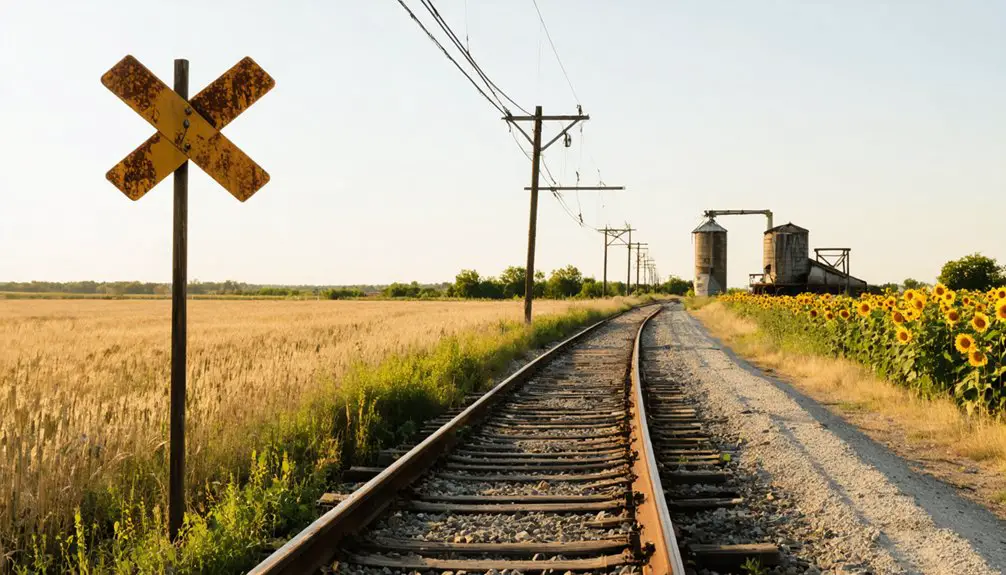
While Monmouth’s merchants built the foundation for local commerce, the arrival of the Memphis, Kansas & Colorado Railroad in 1879 transformed the town into a regional transportation hub.
You’ll find the transportation evolution marked by the line’s conversion to standard gauge in 1882, enhancing the town’s ability to ship grain, produce, and coal throughout the region.
By 1910, communication advancements brought telegraph offices and express services, connecting Monmouth’s 400 residents to the wider world. You could send money orders through the post office or conduct business through the railway depot, managed by the St. Louis and San Francisco Railway.
The town’s strategic position linked it to Cherokee, Parsons, and other regional markets until shifting transportation patterns and declining rail service eventually led to its downturn.
The Path to Abandonment
As the dawn of the 20th century approached, Monmouth’s steady decline became increasingly apparent through the closure of essential institutions and services.
The town’s economic challenges mounted as traditional industries faded and technological advances reduced agricultural labor needs.
Automation and shifting market forces dealt fatal blows to Monmouth’s economy, leaving once-bustling industries to wither and farms understaffed.
You’ll find three key factors that sealed Monmouth’s fate:
- Loss of crucial services, including the post office, which stripped away the town’s communication hub
- Steady population shifts as younger residents sought opportunities in larger urban centers
- Competition from neighboring towns with stronger economies and better mineral resources
Without political incorporation or railroad connections, Monmouth couldn’t compete with more prosperous communities.
The exodus accelerated as schools consolidated, churches closed, and social gathering places disappeared.
The once-thriving farming community gradually transformed into another Kansas ghost town, its remaining structures standing as silent witnesses to its former vitality.
Physical Remnants and Archaeological Evidence
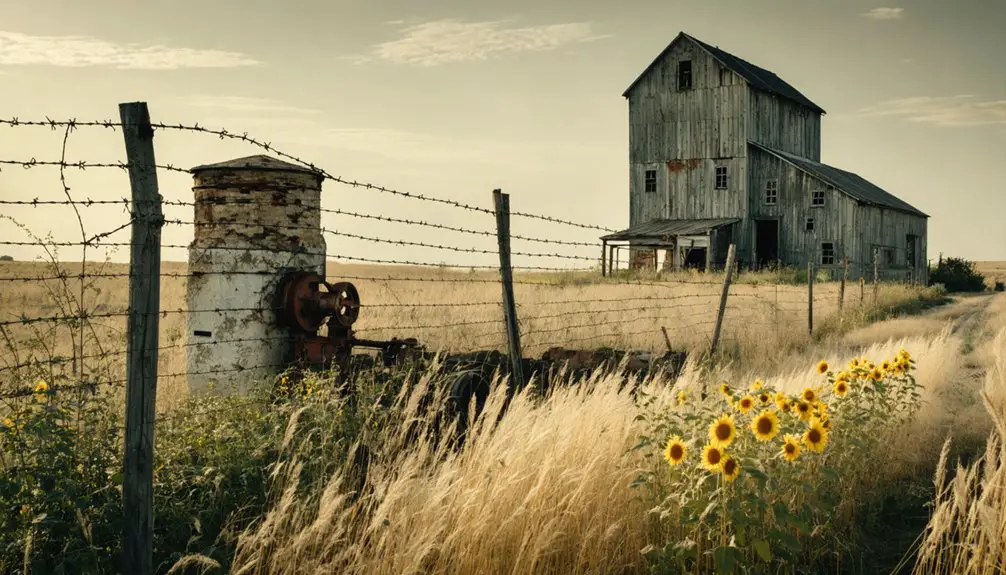
The physical remnants of Monmouth tell a compelling story of both presence and absence. While you won’t find any standing structures from the town’s heyday, archaeological finds reveal traces of its 1870s prosperity, when two churches, a sawmill, and various businesses lined its streets.
The original two-story log house built by Lafayette Manlove in 1866 has vanished, but beneath the soil, structural remnants likely persist.
You’ll discover that systematic archaeological surveys have documented scattered artifacts throughout the area, including pottery sherds and worked stone tools.
The town’s position near Lightning and Limestone Creeks has left subtle landscape signatures, while modern GIS mapping helps preserve the precise location of this vanished settlement for future study and exploration.
Legacy in Crawford County History
Founded in 1866 by Lafayette Manlove, Monmouth stands as a tribute to Crawford County‘s pioneering spirit and early settlement ambitions.
You’ll find its industrial heritage deeply woven into Southeast Kansas’ coal mining narrative, particularly during the 1920s boom that transformed the region’s economic landscape.
- The town’s Methodist Episcopal and Presbyterian churches helped forge community bonds while integrating diverse immigrant populations.
- Monmouth’s strategic location along the Memphis, Kansas & Colorado Railroad positioned it as a crucial transportation hub.
- The community’s early development of schools and commerce established a blueprint for other Crawford County settlements.
Today, Monmouth’s cultural influences echo through the “Little Balkans” heritage, reminding you of the immigrant miners who shaped Crawford County’s identity during its industrial peak.
While the physical town has faded, its legacy endures in regional history.
Frequently Asked Questions
What Natural Disasters or Epidemics Affected Monmouth During Its Existence?
You won’t find records of major natural disasters or epidemic outbreaks affecting the town, though it faced typical frontier risks like creek flooding and common regional diseases of 1800s Kansas.
Are There Any Descendants of Lafayette Manlove Still Living in Kansas?
You’ll find that while Manlove lineage can be traced through Kansas heritage records, there’s not enough conclusive evidence to definitively confirm whether Lafayette Manlove’s direct descendants still reside in Kansas today.
What Happened to the Church Buildings After the Town’s Decline?
You’ll find most church buildings fell into disrepair and collapsed, though one 1800s stone church still stands as a deteriorating remnant. Without historical preservation efforts, nature’s reclaimed these once-sacred structures.
Were There Any Notable Crimes or Lawlessness in Monmouth’s History?
You won’t find major crime statistics or notable law enforcement conflicts in Monmouth’s records. Unlike surrounding areas that faced outlaw violence, this quiet settlement stayed remarkably peaceful throughout its existence.
Did Native American Tribes Have Any Significant Interactions With Monmouth Settlers?
You won’t find records of significant cultural exchanges or trade relations between Monmouth settlers and Native tribes, as most Indigenous peoples had already been forcibly relocated before the town’s 1866 establishment.
References
- https://legendsofkansas.com/monmouth-kansas/
- https://www.youtube.com/watch?v=iB5rHT14eVI
- https://legendsofkansas.com/kansas-ghost-town-list/
- https://www.youtube.com/watch?v=alC1wDdSVvg
- https://www.legendsofamerica.com/whats-new/
- https://www.ksgenweb.org/archives/crawford/history/1905/027.html
- https://legendsofkansas.com/crawford-county-kansas/
- http://pittsburgksmemories.com/Crawford_County/CC_Towns/cctownmonmouth.html
- https://ia803106.us.archive.org/20/items/twentiethcentury00chic/twentiethcentury00chic.pdf
- http://www.kancoll.org/books/cutler/crawford/crawford-co-p2.html
